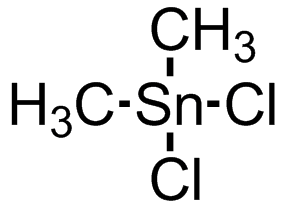Dimethyltin dichloride
Dimethyltin dichloride is an organic compound with the molecular formula C2H6Cl2Sn. It is a white crystalline powder, soluble in non-polar organic solvents and readily soluble in water and lower alcohols. Used as magnesium or magnesium alloy corrosion inhibitor, polyvinyl chloride stabilizer, electroluminescent material and catalyst, etc.

Chinese name: dimethyltin dichloride (DMTC)
English name: Dimethyltin Dichloride
CAS NO:753-73-1
Molecular formula: C2H6Cl2Sn
Relative molecular mass: 219.57
Structural formula: (CH3)2SnCl2
Technical index
Item
Indicator
Appearance
White crystalline powder
Dichlorodimethylstannane content(%)
≥95.0
Trichloromethylstannane content(%)
≤5.0
Monochlorotrimethyltin content(%)
≤0.2
Total tin content (%)
≥52.0
Melting point(℃)
107-108
Boiling point (℃)
188-190
Bulk density(25℃) g/cm
1.30±0.3
Water content(%)≤
0.8
Solubility
Soluble in non-polar organic solvents, easily soluble in water and low grade alcohols
Electrical conductivity
Aqueous solution is acidic and conductive
Corrosiveness
Very corrosive, not suitable for use in metal vessels
Main applications:
Mainly used in Low-E glass coating material, glass bottle hot end spray coating, esterification reaction catalyst and other fields.
Production method
The molten metal tin is refined by reacting with chloromethane under the action of catalysts such as tetramethylammonium chloride.
Toxicity: moderate toxicity.
Emergency treatment methods
1. Leakage emergency treatment
Isolate the leaking contaminated area, set up warning signs around and restrict access. Emergency personnel wear gas masks (full face mask) and gas-proof clothing. Carefully put away, place in plastic bags, seal and transfer to safe place. The collected residue is soaked in dilute alkaline water and the generated solids are recycled and collected and sent to the production plant for disposal.
2. Protective measures
Engineering control: The production process is closed and ventilation is strengthened.
Respiratory protection: When the concentration in the air exceeds the standard, it is recommended to wear self-absorbing filtered dust mask.
Eye protection: Wear chemical safety glasses.
Body protection: Wear anti-poison penetration work clothes.
Hand protection: Wear chemical resistant gloves.
Other protection: Change and wash work clothes in time. Maintain good hygiene practices.
Hazardous characteristics: No special combustion and explosion characteristics.
3. First aid measures
Skin contact: Remove contaminated clothing, rinse thoroughly with soapy water and water, and seek medical attention.
Eye contact: Lift eyelids, flush with running water for 20 minutes, seek medical attention.
Inhalation: Remove from the scene to fresh air. If breathing is difficult, give oxygen and seek medical attention.
Ingestion: For accidental ingestion, drink appropriate amount of warm water and induce vomiting. Gastric lavage, drainage, seek medical attention.
Storage
Store at a temperature of 30°C or below, in a cool, dry place, and seal tightly immediately after use.
Packaging and transportation
Packaging: It is advisable to use glass containers, plastic containers, metal vessels resistant to chlorine corrosion, sealed and stored.
Transportation: loading and unloading should be lightly loaded and unloaded, and the package should be prohibited from breaking during transportation, and should be sealed tightly immediately when damage is found, and diluted with large amount of alkaline water for trace leakage.
Waste disposal
Transport to the production plant for disposal.


Comments